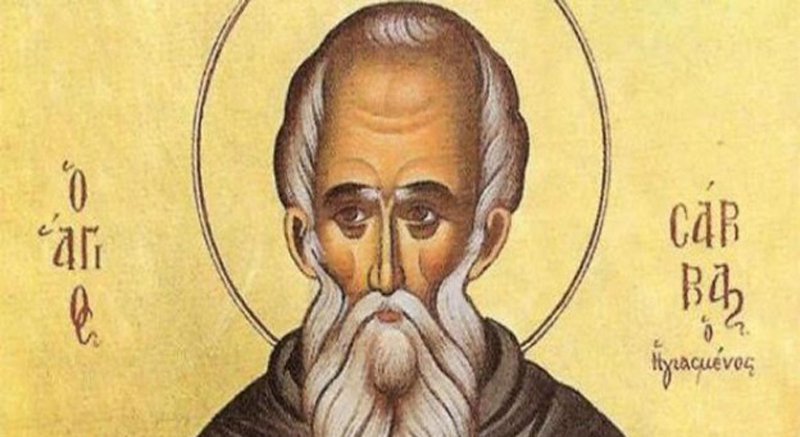(439 -531)
St. Sabas was born near Caesarea, and as a child was orphaned.
At the age of 15, having suffered the abuse of his uncle, he decided to forsake the world and enter a monastery not far from his family home. He then spent 10 years in religious life and despite being the youngest of the monks in the monastery.
Sabas demonstrated admirable virtue and was looked upon with great respect and love by his brothers. Upon pressure from his remaining family, who continuously besieged him with requests to give up religious life, he asked, “Do you want me to be a deserter, leaving God after placing myself in His service? If those who abandon the militia of earthly kings are severely punished, what chastisement would I not deserve if I abandoned that of the King of heaven?”
When he was 30, desiring greater solitude, he began to live in a cavern on a mountain near Jerusalem, where he prayed, sang psalms and wove baskets of palm branches. He was 45 when he began to direct those who came to live as hermits, as he did, and he gave each of them a place to build a cell; soon this was the largest monastery of Palestine.
He left the region when certain agitators complained about him, for his incapability of maintaining good discipline. The Patriarch of Jerusalem, Sallustus, did not easily credit the complaints, and instead ordained Sabas a priest, so that he might say Mass for his disciples — for they had been displeased by his lack of desire for that honor. He was at that time fifty-three years old. The patriarch presented him to them as their father, whom they should obey and honor, and made him Superior of all the Palestine monasteries. But several monks remained obstinate, and St. Sabas again went elsewhere, to a cavern near Scythopolis.
St. Euthymius told a story of how Sabas went into a great cave to pray, unknowingly entering the cave of a great lion out for the hunt. At midnight, the beast returned and finding this guest, dared not touch him, but taking him gently by his garments, plucked him as if to draw him out. “The saint was in no way frighted or troubled but began leisurely and with much devotion to recite aloud the midnight psalms. The lion went out, and when the holy man had finished matins, came in again and pulled him by the skirts of his clothes as he had done before.” Sabas spoke to the lion, stating that the cave was large enough to house both of them. The lion at those words departed and returned no more.
After some time, during which he converted many souls who visited him, he returned to his role as superior. He administered seven monasteries and began exerting influence not only in Palestine, but in Constantinople as well. St. Sabas advocated for the Catholics in Constantinople who were suffering greatly under the rule of Emperor Elias. He wrote letter after letter, begging the emperor for fairer treatment of the Church, fewer taxes, and an end to persecution. Eventually, the emperor died and was replaced with Emperor Justin, a pious man who restored the true faith.
When St. Sabas was 90, he made the long journey to Constantinople to ask Justinian, successor to Justin, not to act with severity against the province of Palestine, where a revolt had occurred by the non-submission of a group of Samaritans.
The emperor honored him highly and wished to endow his monasteries with wealth, but the holy patriarch asked him to use the riches he was offering to build a hospice for pilgrims in Jerusalem, to decorate the unfinished Church of the Blessed Virgin, to build a fortress where the monks could take refuge when barbarians invaded the land, and finally, to re-establish preaching of the true Faith, by edicts proscribing the various errors being propagated.
Sabas returned home and appointed his successor and rested for four days before he died. The holy abbot lived to be 92, and died in 531, in the arms of the monks of his first monastery.
Sabbas’ relics were taken by crusaders in the 12th century and remained in Italy until Pope Paul VI returned them to the monastery in 1965 as a gesture of good will towards the Orthodox.
His Great Lavra long continued to be the most influential monastery in those parts, and produced several distinguished monks, among them St. John of Damascus. It is now known as the monastery of Mar Saba. The church of San Saba in Rome is dedicated to him.
Adapted by A.J. Valentini from Masters, E. (2018, December 5). St. Sabas, Abbott. Regina Foundation of Oregon. https://www.reginamag.com/saint-sabas-abbot/
